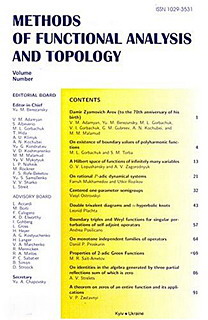Vol. 17 (2011), no. 3
On generalized selfadjoint operators on scales of Hilbert spaces
Yu. M. Berezansky, J. Brasche, L. P. Nizhnik
MFAT 17 (2011), no. 3, 193-198
193-198
We consider examples of generalized selfadjoint operators that act from a positive Hilbert space to a negative space. Such operators were introduced and studied in [1]. We give examples of selfadjoint operators on the principal Hilbert space $H_ 0$ that, being considered as operators from the positive space $H_ + \subset H_ 0$ into the negative space $H_ - \supset H_ 0$, are not essentially selfadjoint in the generalized sense.
On the group of Lie-orthogonal operators on a Lie algebra
S. V. Bilun, D. V. Maksimenko, A. P. Petravchuk
MFAT 17 (2011), no. 3, 199-203
199-203
Finite dimensional Lie algebras over the field of complex numbers with a linear operator $T: L\to L$ such that $[T(x),T(y)]=[x,y]$ for all $x,y\in L$ are studied. The group of such non-degenerative linear operators on $L$ is considered. Some properties of this group and its relations with the group $\operatorname{Aut}(L)$ in the general linear group $GL(L)$ are described.
Positive operators on the Bergman space and Berezin transform
MFAT 17 (2011), no. 3, 204-210
204-210
Let $\mathbb{D}=\{{z\in\mathbb{C}:|z|<1}\}$ and $L^2_a(\mathbb{D})$ be the Bergman space of the disk. In thispaper we characterize the class $\mathcal{A}\subset L^\infty(\mathbb{D})$ such that if $\phi,\psi\in\mathcal{A},\alpha\geq 0$ and $0\leq\phi\leq\alpha\psi$ then there exist positive operators $S,T\in\mathcal{L}(L^2_a(\mathbb{D}))$ such that $\phi(z)=\widetilde{S}(z)\leq\alpha\widetilde{T}(z)=\alpha\psi(z)$ for all $z\in\mathbb{D}$. Further, we have shown that if $S$ and $T$ are two positive operators in $\mathcal{L}(L^2_a(\mathbb{D}))$ and $T$ is invertible then there exists a constant $\alpha\geq0$ such that $\widetilde{S}(z)\leq\alpha\widetilde{T}(z)$ for all $z\in\mathbb{D}$ and $\widetilde{S},\widetilde{T}\in\mathcal{A}$. Here $\mathcal{L}(L^2_a(\mathbb{D}))$ is the space of all boundedlinear operators from $L^2_a(\mathbb{D})$ into $L^2_a(\mathbb{D})$ and $\widetilde{A}(z)=\langle Ak_z,k_z\rangle$ is the Berezintrans form of $A\in\mathcal{L}(L^2_a(\mathbb{D}))$ and $k_z$ is thenormalized reproducing kernel of $L^2_a(\mathbb{D})$. Applications of these results are also obtained.
On one class of nonselfadjoint operators with a discrete spectrum
G. M. Gubreev, M. G. Volkova, A. A. Tarasenko
MFAT 17 (2011), no. 3, 211-218
211-218
In this work completely continious nondissipative operators with two-dimensional imaginary parts, acting in separable Hilbert space are studied. The criteria of completeness and unconditional basis property of root vectors of such operators are obtained. The results are formulated in terms of characteristic matrix-valued functions of nonselfadjoint operators and proved using analysis of functional models in de Branges spaces.
Non-Archimedean unitary operators
MFAT 17 (2011), no. 3, 219-224
219-224
We describe a subclass of the class of normal operators on Banach spaces over non-Archimedean fields (A. N. Kochubei, J. Math. Phys. 51 (2010), article 023526) consisting of operators whose properties resemble those of unitary operators. In particular, an analog of Stone's theorem about one-parameter groups of unitary operators is proved.
Hardy type spaces on infinite dimensional group orbits
O. V. Lopushansky, M. V. Oleksienko
MFAT 17 (2011), no. 3, 225-234
225-234
In Hilbert Hardy spaces of complex analytic functions with infinitely many variables, defined on unitary orbits of locally compact second countable group, the Cauchy type integral formulas are established. Existence of radial boundary values is proved. Results are illustrated for a reduced Heisenberg group.
Hill's potentials in Hörmander spaces and their spectral gaps
V. A. Mikhailets, V. M. Molyboga
MFAT 17 (2011), no. 3, 235-243
235-243
The paper deals with the Hill-Schrödinger operators with singular periodic potentials in the space $H^{\omega}(\mathbb{T})\subset H^{-1}(\mathbb{T})$. The authors exactly describe the classes of sequences being the lengths of spectral gaps of these operators. The functions $\omega$ may be nonmonotonic. The space $H^{\omega}(\mathbb{T})$ coincides with the Hörmander space $H_{2}^{\omega}(\mathbb{T})$ with the weight function $\omega(\sqrt{1+\xi^{2}})$ if $\omega$ is in the Avakumovich class $\mathrm{OR}$.
On asymptotic behavior of the constants in generalized Khintchine's inequality
MFAT 17 (2011), no. 3, 244-251
244-251
We establish an asymptotic behavior of the constants in Khintchine's inequality for independent random variables of mean zero.
On *-representations of a class of algebras with polynomial growth related to Coxeter graphs
MFAT 17 (2011), no. 3, 252-273
252-273
For a Hilbert space $H$, we study configurations of its subspaces related to Coxeter graphs $\mathbb{G}_{s_1,s_2}$, $s_1,s_2\in\{4,5\}$, which are arbitrary trees such that one edge has type~$s_1$, another one has type~$s_2$ and the rest are of type~$3$. We prove that such irreducible configurations exist only in a finite dimensional $H$, where the dimension of $H$ does not exceed the number of vertices of the graph by more than twice. We give a description of all irreducible nonequivalent configurations; they are indexed with a continuous parameter. As an example, we study irreducible configurations related to a graph that consists of three vertices and two edges of type $s_1$ and $s_2$.
$\hat{g}$-closed sets in ideal topological spaces
J. Antony Rex Rodrigo, O. Ravi, A. Naliniramalatha
MFAT 17 (2011), no. 3, 274-280
274-280
Characterizations and properties of $\mathcal{I}_{\hat{g}}$-closed sets and $\mathcal{I}_{\hat{g}}$-open sets are given. A characterization of normal spaces is given in terms of $\mathcal{I}_{\hat{g}}$-open sets. Also, it is established that an $\mathcal{I}_{\hat{g}}$-closed subset of an $\mathcal{I}$-compact space is $\mathcal{I}$-compact.


